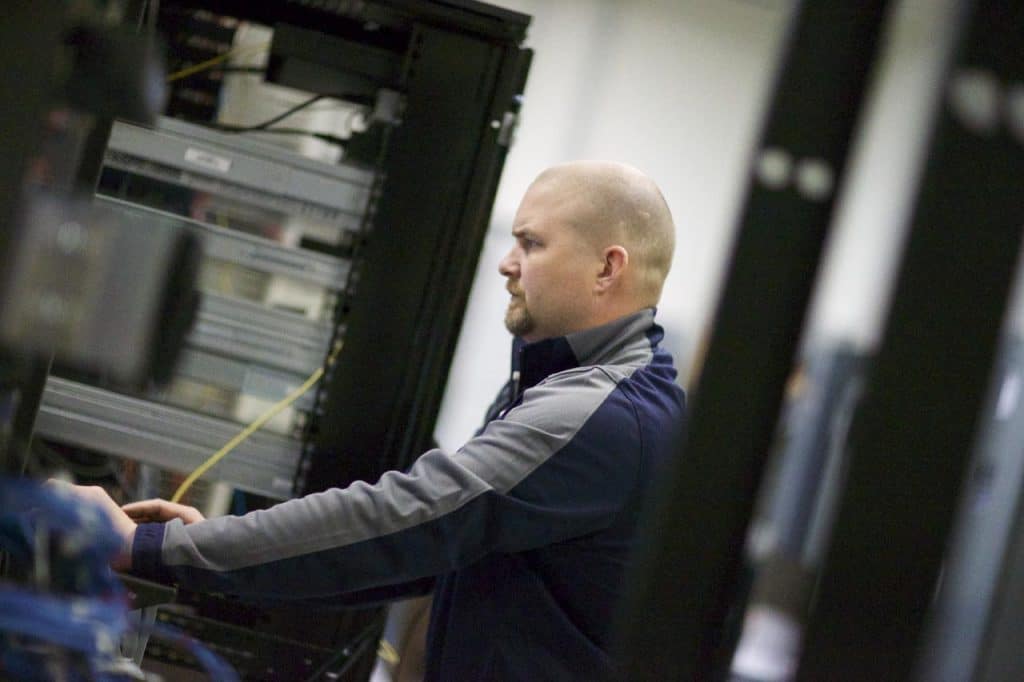When you invest in a physical security system one of the top items to consider is whether you want the data that is captured and stored to be housed at your site or retained in the cloud. Tele-Rad partners with Avigilon, a leading provider of physical security solutions, to offer both types of these solutions. We have access control and surveillance cameras installed throughout our facilities so we can demonstrate it for you in our Grand Rapids experience center, at your operations site, or at any of our company locations. Stop by or schedule an appointment to see it for yourself! We understand that there are benefits and drawbacks with either data storage option, which we will discuss in this blog post.
Comparing the Options
An on-premise solution is housed in a physical location – generally in the same building as the security systems. Recorders, or on-prem servers, capture and store data from security cameras, access control systems, sensors and alarms transmitted over an internal network. We partner with Avigilon to offer their Unity solutions for centralized and scalable on-premise video security.
Cloud security systems capture and store sensitive data in a secure data center in the cloud. The data is transmitted over the Internet. Security teams can access the data via the Internet and review it on a variety of fixed and mobile devices, either on the premises or remotely. When it comes to cloud-based camera solutions, our team works with Avigilon Alta, an end-to-end cloud security suite, equipped with AI-powered analytics and fully integrated technology.
Unified voice, data, video and analytics
Five Factors to Consider
Now that we know a bit more about the options, let’s dive into what we consider to be the top five factors to consider when determining which solution is right for you.
- PHYSICAL SPACE: One of the most important differences between the on-premise and cloud-based options is the location of infrastructure. If space is at a premium, a cloud solution can free space on the premises for other uses. This may be important if space is at a premium, or if you’re in a business where the space can be used to generate additional revenue.
- AVAILABILITY OF IT SUPPORT: If the data storage infrastructure is onsite, the business is responsible for management and maintenance. It is essential that members of your IT support team have the skills and knowledge to manage both the equipment and the internal networks. With an on-premise solution, the IT team is responsible for managing and installing updates and ensuring that the system is always up to date. These solutions also require regular maintenance to ensure reliability, which can be time-consuming for an IT team. However, this also gives the business full control and oversight of their security systems at all times. In a cloud security solution, software updates are often included as part of the service covered by a subscription. With systems that leverage over-the-air (OTA) updates, the newest features and upgrades are implemented automatically, which can help protect against emerging threats or newly discovered vulnerabilities, without occupying as much of your IT team’s time.
- NETWORK CONNECTIVITY: To connect individual security and access control components to on-premise storage devices requires the installation and maintenance of a secure internal data network. The network must have the speed, capacity and traffic prioritization capability to transmit high volumes of data like high-resolution video images for different video surveillance infrastructure without delay or loss of image quality. Companies also need to ensure they hire IT and security teams who will work hard to maintain high security standards, such as setting rules and auditing procedures to minimize the risk of data being compromised. On the other hand, cloud security systems transmit data directly from individual security devices. This can be more efficient than maintaining your own internal data network, but you may wish to consider the risk of security breaches during data transmission.
- COST: Initial investment vs. subscription-based costs are generally a big factor in these decisions. On-premise security data systems often require a higher initial capital investment. They will also require some ongoing costs such as renewal of software licenses, maintenance and repair, and IT costs such as installation of software updates and upgrades. Most costs for cloud security systems are subscription-based, including software license fees, software updates, system management and maintenance. Cloud storage also offers opportunities for cost savings in other areas, such as easier deployment and management of the system.
- CAPACITY AND SCALABILITY: Equipment used in on-premise solutions generally has a limited storage capacity. As security cameras generate large file sizes, on-premise storage systems may reach their limit and expanding the system may require additional investment. Expansion of the security system, such as additional incoming camera streams, may affect the items listed above, such as space, increased need for support and management, and additional cost. Cloud security systems have infinite storage capacity, although individual storage limits are determined initially by the type of subscription, and additional data streams may also incur additional subscription costs. That said, tiered storage systems are often available, where non-essential or older data can be stored in lower-cost data archives.
If you’re considering investing in one of these security solutions, it’s obvious that you value the safety of your spaces and the integrity of your security data. Make the most of your investment by considering the factors listed above, such as space, cost, availability of network and support, and options for future expansion. Be sure to take a long-term perspective to make the most out of your investment, being sure to balance operational needs and financial considerations. Have additional questions? Ready to discuss options? Our local team of highly-trained technology consultants are here to work with you! Contact us today!
